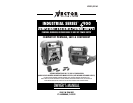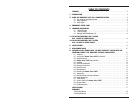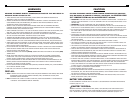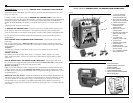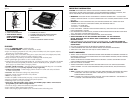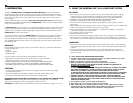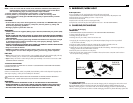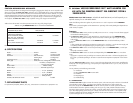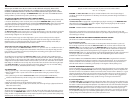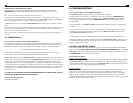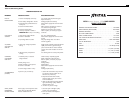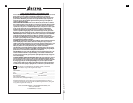
Example: If a load is rated at 100 watts, the power source must be able to deliver:
100 ÷ 10 = 10 amperes
CAUTION: The Power Force 150™ must only be connected to batteries with a nominal output voltage of
12-volts DC. The unit will not operate from a 6-volt battery and will sustain permanent damage if connected to a
24-volt battery.
8.3.2 Connecting To Power Source
The Power Force 150™ is equipped with a cigarette lighter-type plug for connecting it to the INDUSTRIAL 900™.
The tip of the plug is positive and the side contact is negative. Simply insert the plug firmly into the 12-volt DC
socket on the front of the
INDUSTRIAL 900™.
CAUTION—REVERSE POLARITY CONNECTION WILL RESULT IN DAMAGE TO THE INVERTER.
If the inverter is connected to the incorrect polarity, the fuse will be blown. If the unit does not function after
replacement of the fuse, the unit must be returned to Vector for repair. Repair expenses for this type of damage are
not covered by your warranty.
CAUTION: DO NOT USE WITH POSITIVE GROUND ELECTRICAL SYSTEMS.
(THE MAJORITY OF MODERN AUTOMOBILES, RVs, AND TRUCKS ARE NEGATIVE GROUND)
8.3.3 Connection To Load
Make sure that the ON/OFF switch on the inverter is in the OFF position. Remove the inverter ‘s power cord
from its storage compartment and connect the
Power Force 150™ to the 12-volt DC socket on the front of the
INDUSTRIAL 900™. Leave the ON/OFF switch on the INDUSTRIAL 900™ in the OFF position, and then turn the
inverter‘s ON/OFF switch to the ON position. The inverter ‘s green LED indicator will illuminate to indicate that
the unit is functioning. Make sure the load requirements of your equipment are within the parameters of the
Power Force 150™ output. If so, plug the appliance into the standard household-type AC outlet on the inverter and
turn ON your equipment. If an audible alarm sounds, refer to the Troubleshooting section of this manual for
probable causes and recommendations.
DO NOT CONNECT TO AC DISTRIBUTION WIRING: The
Power Force 150™ is engineered to be connected
directly to standard electrical and electronic equipment in the manner described above. Do not connect the Power
Inverter to household or RV AC distribution wiring. Do not connect the Power Inverter to any AC load circuit in
which the neutral conductor is connected to ground (earth) or to the negative of the DC (battery) source.
CAUTION: RECHARGEABLE APPLIANCES
Certain rechargeable devices are designed to be recharged by plugging them directly into an AC receptacle. These
devices may damage the
Power Force 150™. When first using a rechargeable device, monitor its temperature for
the initial ten minutes of use to determine whether it emits excessive heat. If excessive heat is detected, it is a good
indication that the device should not be used with this inverter. This problem does not occur with the majority of
battery-operated equipment. Most of these devices use a separate charger or transformer that is plugged into an
AC receptacle. The
Power Force 150™ is easily capable of running most chargers and transformers.
8.3.4 Fuse Replacement
If the Power Force 150™ is overloaded and the spade type fuse (30A) is blown, flip up the fuse replacement cover
on the back of the
Power Force 150™ and replace the blown fuse with a new spade type, 30 Amp fuse, available
from Vector™ Customer Service Department (954) 923-1155. Determine the cause of the short before restarting the
Power Force 150™ again. Fuse Replacement in automobile (only applies when using inverter direct from vehicle):
Most automobile cigarette lighter circuits use fuses at 15 Amps or less. In order to maximize the output of your
Power Force 150™ and minimize the possibility of shutdown due to a blown fuse in your vehicle, it may be neces-
sary to replace the existing fuse in your automobile cigarette lighter circuit with a minimum 15 amp fuse. This fuse
amperage change will not affect performance or any other aspect of this circuit.
To ensure years of reliable service, the power inverter must be installed and used properly. Please read the
installation and operating instructions thoroughly prior to installation and use. Pay particular attention to the
CAUTION and WARNING statements in this manual. The CAUTION statements advise against certain conditions
and practices that may result in damage to the
INDUSTRIAL 900™ and/or the inverter. The WARNING statements
identify conditions or practices that may result in personal injury or loss of life.
8.2 HOW THE VECTOR™ Power Force 150™ INVERTER WORKS
The Power Force 150™ inverter is an electronic device that converts low voltage DC (direct current) electricity from
a 12-volt DC vehicle battery or other 12-volt DC power source (like the
INDUSTRIAL 900™ system) to standard
110-volt AC (alternating current) household power. In designing the
Power Force 150™, Vector™ has incorporated
design techniques previously employed in computer power supplies. The result of these design innovations is a
smaller, lighter and easier-to-use power inverter.
8.2.1 Vector™ Power Force 150™ Inverter—Principle Of Operation
The Power Force 150™ inverter converts power in two stages. The first stage is a DC-to-DC conversion process that
raises the low voltage DC at the inverter input to 14.5-volts DC. The second stage is the actual inverter stage that
converts the high voltage DC into 110-volts, 60 Hz AC.
The DC-to-DC converter stage uses modern high frequency power conversion techniques that have replaced
the bulky transformers found in less technologically-advanced models. The inverter stage uses advanced power
MOSFET transistors in a full bridge configuration. This ensures excellent overload capability and the ability to
operate reactive loads like lamp ballasts and small induction motors.
8.2.2 Power Force 150™ Output Waveform—Modified Sine Wave
The AC output waveform of the Power Force 150™ is known as a “quasi-sine wave” or a “modified sine wave”. It
is a stepped waveform that is designed to have characteristics similar to the sine wave shape of utility power. This
type of waveform is suitable for most AC loads, including linear and switching power supplies used in electronic
equipment, transformers, and motors.
The modified sine wave produced by the
Power Force 150™ inverter is designed to have an RMS (root mean
square) voltage of 115-volts, which is the same as standard household power. Most AC voltmeters ( both digital and
analog) are sensitive to the average value of the waveform rather than the RMS value. They are calibrated for RMS
voltage under the assumption that the waveform measured will be a pure sine wave. These meters will not read the
RMS voltage of a modified sine wave correctly. They will read about 20 to 30 volts low when measuring the output
of the
Power Force 150™. For accurate measurement of the output voltage of this unit, use a true RMS reading
voltmeter such as a Fluke 87, Fluke 8060A, Beckman 4410, or a Triplett 4200.
8.3 INSTALLATION
1.See Fig. (2) #4 on page 1 of this manual (Using the INDUSTRIAL 900™ as a 110-volt Power Supply).
2.Make sure that the inverter ‘s power switch is in the OFF position before making any connection to power
source or load.
3.Line up the housing on the Vector™
Power Force 150™ inverter (sold separately for Model VEC021;
included with Model VEC021AC) with the mounting walls on the back of the
INDUSTRIAL 900™. Slide the invert-
er
into place, from right to left. See Fig.(2) #4.
4.Note the convenient built-in cord storage above the inverter mounting.
5.NOTE: Once inverter is properly in place, lock-in tab button, then on the right will pop up (depress tab button to
release and remove inverter).
8.3.1 Power Source Requirements
The power source must provide between 11 and 14.5-volts DC and must be able to supply the necessary current to
operate the load. The
INDUSTRIAL 900™ contains a 12-volt DC 17 amp hour maintenance-free sealed lead acid
battery. To obtain a rough estimate of the current (in amperes) required to operate a particular device (load), simply
divide the power consumption of the load (in watts) by 10.
12 13



